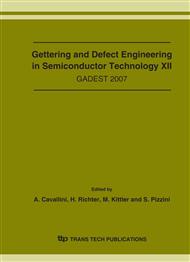[1]
C. M. Carbonaro, V. Fiorentini, and F. Bernardini. Phys. Rev. B. Vol. 66 (2002), p.233201.
Google Scholar
[2]
X. Yu, D. Yang, X. Ma, H. Li, Y. Shen, D. Tian, L. Li and D. Que, J. Cryst. Growth Vol. 250(2003), p.359.
Google Scholar
[3]
D. Yang, X. Yu, X. Ma, J. Xu, L. Li and D. Que, J. Cryst. Growth Vol. 243 (2002), p.371.
Google Scholar
[4]
T. Taishi, X. Huang, I. Yonenaga and K. Hoshikawa. Mater. Sci. in Semi. Proc. Vol. 5 (2003), p.409. 5. E. Hild, P. Gaworzewski, M. Franz and K. Pressel, Appl. Phys. Lett. Vol 72 (1998), p.1362.
DOI: 10.1063/1.121055
Google Scholar
[6]
H. Li, D. Yang, X. Yu, X. Ma, D. Tian, L. Li and D. Que, J Phys: Condens Matter, Vol. 16 (2004), p.5745.
Google Scholar
[7]
C. Cui, D. Yang, X. Ma, M. Li, D. Que, Mater. Sci. in Semi. Proc. Vol. 9 (2006), p.110.
Google Scholar
[8]
C. S. Fuller, N. B. Ditzenberger, N. B. Hannay and E. Buchier, Phys. Rev. Vol. 96 (1954), p.833.
Google Scholar
[9]
C. S. Fuller and R. A. Logan, J. Appl. Phys. Vol. 28 (1957), p.1427.
Google Scholar
[10]
J. A. Griffin, J. Hartung, and J. Weber, Mater. Sci. Forum Vol. 619 (1989), p.38.
Google Scholar
[11]
D. Yang, D. Que, K. Sumino, Appl. Phys. Lett. Vol. 77(1994), p.943.
Google Scholar
[12]
A. R. Been and R. C. Newman: J. Phys. & Chem. Solids Vol. 33 (1972), p.255.
Google Scholar
[13]
R. C. Newman, A. S. Oates and F. M. Livingston, J. Phys. C: Solid State Phys. Vol. 16 (1983), p. L667.
Google Scholar
[14]
A. Misiuk, D. Yangb, B. Surma, C.A. Londos, J. Bak-Misiuk and A. Andrianakis, Materials Science in Semiconductor Processing Vol. 9 (2006), p.82.
DOI: 10.1016/j.mssp.2006.01.031
Google Scholar
[15]
P. Wagner and J. Hage, Appl. Phys. A: Solid. Surf. Vol. 49(1989), p.123.
Google Scholar
[16]
J. Chen, D. Yang, H. Li, X. Ma and D. Que, J. Cryst. Growth Vol. 291 (2006), p.66.
Google Scholar
[17]
H. J. Stein, S. K. Hahn and S. C. Shatas, J. Appl. Phys. Vol 59(1986), p.3495.
Google Scholar
[18]
V. V. Voronkov, G. I. Voronkova, A. V. Batunina, V. N. Golovina, M. G. Mil'vidskii, A. S. Gulyaeva, N. B. Tyurina and L. V. Arapkina, Phys. Sol. Stat. Vol. 42(2000), p. (2022).
DOI: 10.1134/1.1324035
Google Scholar
[19]
U. Gosele and T. Y. Tan, Appl. Phys. A: Solids Surf. Vol. 28(1982), p.79.
Google Scholar
[20]
L. I. Murin, T. Hallberg, V. P. Markevich and J. L. Lindstrom, Phys. Rev. Lett. Vol. 80(1998), p.93.
Google Scholar
[21]
S. Oberg, C. P. Ewels, R. Jones, T. Hallberg, J. L. Lindstrom, L. I. Murin and P. R. Briddon , Phys. Rev. Lett. Vol. 81(1998), p.2930.
Google Scholar
[22]
D. Aberg, B. G. Svensson, T. Hallberg and J. L. Lindstrom, Phys. Rev. B. Vol. 58(1998), p.12944.
Google Scholar
[23]
L. C. Snyder, J. W. Corbett, P. Deak, and R. Wu, Mater. Res. Soc. Symp. Proc. Vol. 104(1988), p.179.
Google Scholar


